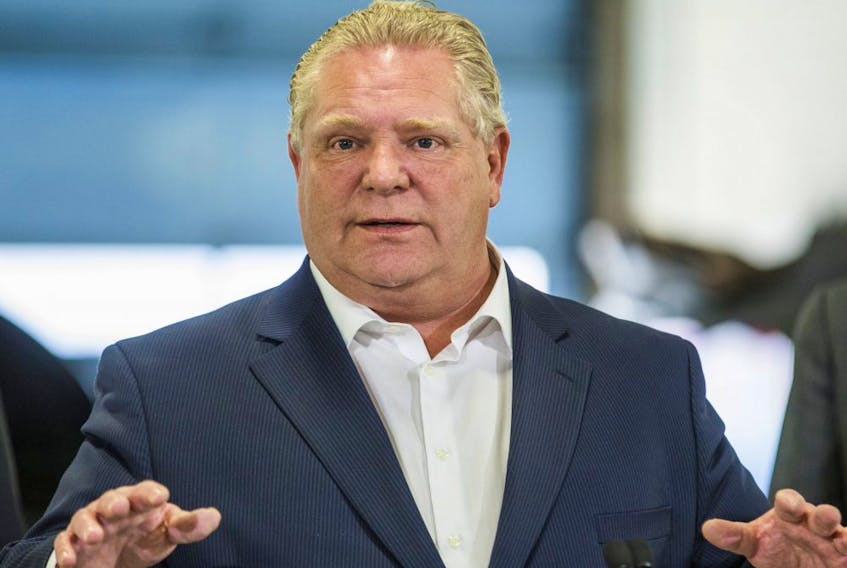Leave it to modern Canadian politics to take a novel, positive development in civic life and fast-track it to the worst-case scenario outcome: On Tuesday, Ontario’s Progressive Conservative government released an advertisement that essentially weaponized provincial Court of Appeal Justice James MacPherson against the federal government’s carbon tax. It is a most unwelcome development.
The ad depicts MacPherson sparring with government lawyer Sharlene Telles-Langdon during this week’s hearings on the constitutionality of the carbon tax, which Ontario is challenging. Ontario reduced its greenhouse gas emissions by 22 per cent over 14 years, MacPherson observes. Telles-Langdon agrees, but notes this was done through shutting down coal-fired power plants. “We don’t care how they achieve it,” MacPherson shoots back. “Why don’t you just leave them alone?”
Telles-Langdon observes that other provinces haven’t fared nearly so well, and argues the goal is uniform price signal across the country. “So Ontario has to pay an extra penalty because other provinces are failing?” asks MacPherson.
That’s where the ad ends.
“Watch this incredible exchange from Ontario’s court challenge of the unconstitutional federal carbon tax.,” Premier Doug Ford’s Twitter account enthused. “We’ve done more than our fair share to meet emissions reduction targets, but the federal government still wants to punish Ontario with a job-killing carbon tax.”
We wouldn’t normally have such footage at all, of course. The Supreme Court of Canada broadcasts its proceedings, but Canadian courtrooms, generally speaking, remain allergic to cameras. Ontario’s and Saskatchewan’s courts of appeal decided their respective carbon tax challenges were of particular interest, however, and it should all have been for the good.
“We hope that livestreaming will help the public to better understand both the legal issues at stake and the hearing process,” Saskatchewan Chief Justice Robert Richards wrote in a statement.
That’s a lovely idea, if far-fetched. The core audience is clearly professors, journalists, wonks and obsessives who would love to be there in person but can’t be. But that, of course, is the key argument for televising courtroom proceedings, absent compelling reasons not to: If we believe in the value of open courtrooms, and supposedly we do, then why open them only a crack? Why make journalists the gatekeepers? Surely if we entrust the average Canadian citizen to be a juror, we can trust him to view courtroom proceedings without, oh, say, splicing and dicing the footage misleadingly and republishing it for his own personal gain.
Alas, we can’t even trust Canada’s second-largest government not to do that.
Even a courtroom newbie watching the testimony would have understood MacPherson was testing Telles-Langdon’s arguments, not professing a personal opinion on the matter. “That’s what judges will do: they’ll try to test the other side’s argument; they’ll make statements to try to tease out different aspects of the case,” says University of Ottawa law professor Amy Salyzyn.
Salyzyn has argued for more broadcast access to Canadian courtrooms. But she says “there’s a risk … what was actually happening can be misunderstood” if people only see one side of what went on.
Indeed, our courtroom newbie might have been rather impressed by Telles-Langdon’s response to Justice MacPherson’s question of “extra penalty”: It’s not about penalty or burden, because the carbon tax gets rebated to those who pay it; the government’s goal isn’t to spread around pain, but to establish a uniform “price signal” across the country with a goal of reducing nationwide emissions. Not surprisingly, that’s not included in the ad.
Judges have personal opinions, of course. It’s silly to pretend courtrooms are entirely above politics. And limits on the use of footage from open courtrooms should be applied as judiciously as limits on Canadians’ access to those courtrooms. But the overt politicization of the judiciary is very much something to be nipped in the bud: Salyzyn says she’s never seen courtroom footage used to partisan advantage in this way, abut it’s easy to imagine others following Ford Nation down the same path. And unlike, say, the government of the day leaking details of a potential Supreme Court appointment and suggesting he doesn’t understand the Charter of Rights, this is a relatively simple problem to solve.
The Supreme Court sets stringent conditions on the use of its broadcasts, Salyzyn notes. They don’t explicitly include not hacking up footage for the purposes of manipulating the public, but that might be worthy of inclusion starting now. A judge’s wrath is nothing to take lightly, even for a government. We needn’t let the excellent goal of a more accessible and well-understood judicial system get dragged down into the cesspool we’ve made of politics.
• Email: [email protected] | Twitter: cselley
Copyright Postmedia Network Inc., 2019









